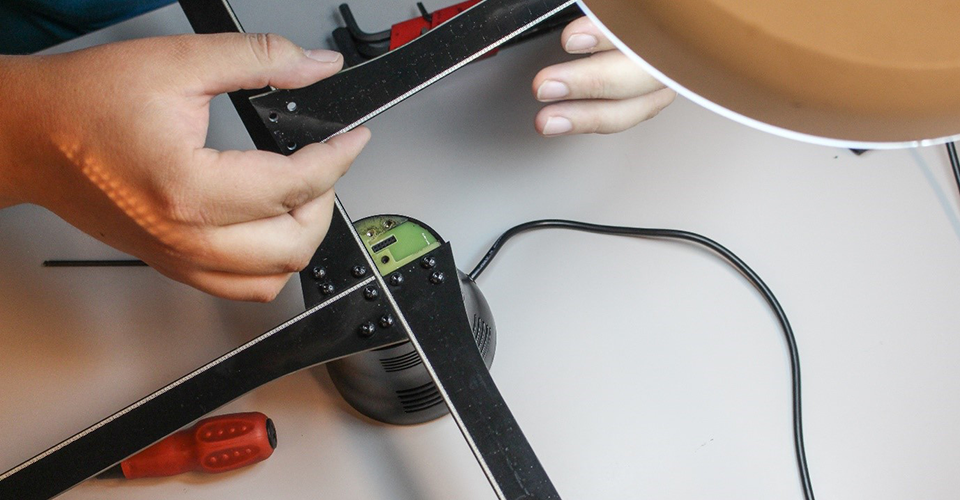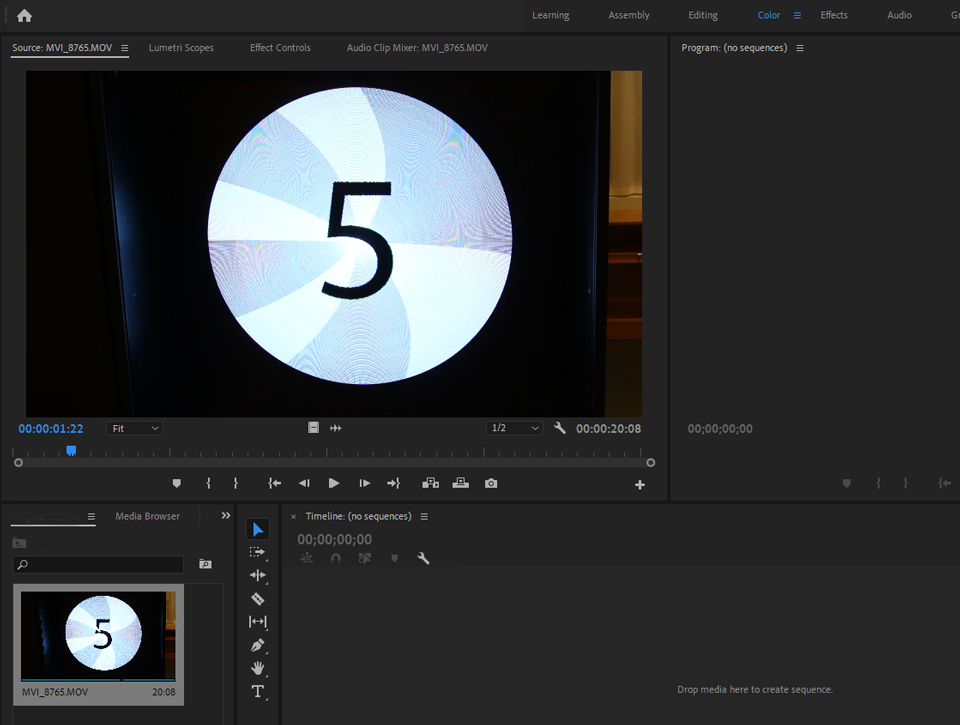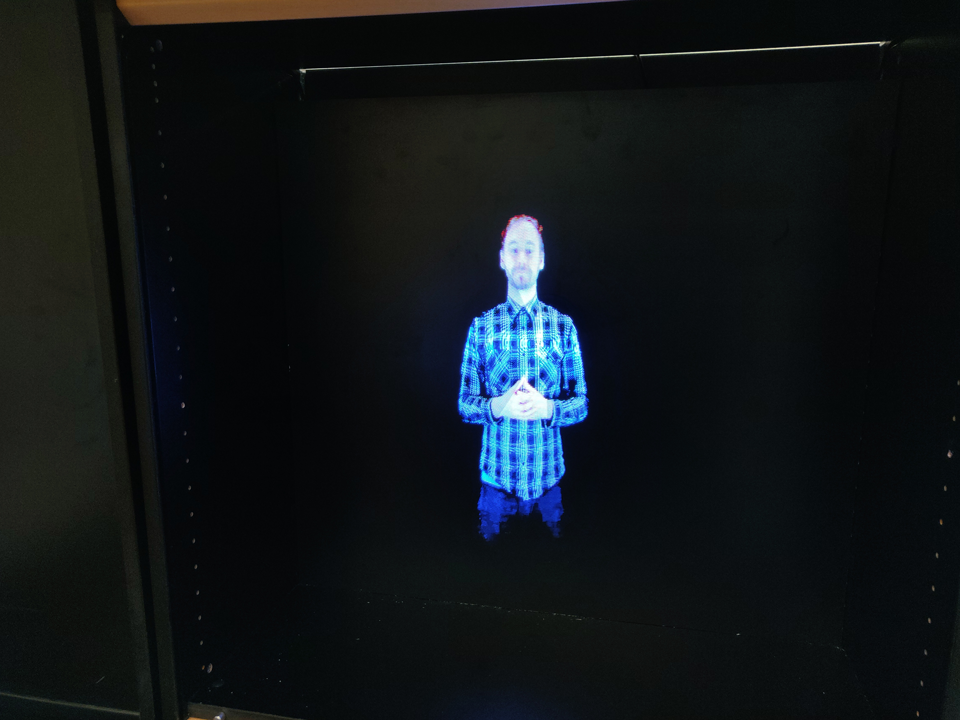
Petri Salo, Mika Virolainen & Merja Saarela
Holographic fan produces an illusion of 3D objects floating in the air. The fast spinning fan becomes nearly invisible to the naked eye and the projected object thus gets a see-through background. The fans are mainly intended for use in advertisement and marketing in shopping malls, airports or other public areas.
Introduction
Holographic fans are types of displays that produce a holographic-like image seemingly floating in the air, by having strips of RGB LEDs attached to the blades of the fan and a control-unit lighting up the pixels as the fan turns around, to produce the full picture. This will trick the observer’s brain to see the image as a whole and perceive the displayed object floating in the air as the observer can see through the fast spinning display.
This project was a research and development project for a client company G2xBit Incorporated and the target was to find out what is needed to achieve high definition holographic images using the given technology, in which a spinning fan, using LEDs attached to the fans blades, produces the holographic images.
The client company G2xbit Inc. is a US-based company with headquarters in Palo Alto, Silicon Valley, California, and a site office in Malmö, Sweden. They are focused on game development as well as on new emerging technologies, like holographic projection. The project was made in close collaboration with Häme University of Applied Sciences from Finland. G2xbit Inc. is the owner and leader of the project with their CEO Tibor Gencel as Project Owner and Manager. Weekly project meetings were held through Skype for Business.
Project team was an international setup, as there were also two exchange students involved in this project. Their focus was in creating 3D models and other graphical aspects for demonstrative and illustrative purposes in this project. While the exchange students focused on doing the 3D modeling, the two staff members assigned to this project focused on the research part.
Case study
The case study focused on getting familiar with how the current technology works and what modifications would be needed to the design in order to meet client’s desired specifications.
So a specimen of the current holographic fan technology was acquired. The product was purchased from a Chinese vendor, Shenzhen Baotianxiang Technology Company, which is located in the city of Shenzhen in mainland China.
The aim of the study was to find out parameters needed to achieve 1080 pixel resolution.
The holographic fan used as a pilot device in this project has four fan blades, with 256 LEDs attached to each blade. This setup works as a 56 centimeters or 512 pixels wide circular display, with an area of the produced circle being 0.2 million pixels. In comparison, the targeted 1080p resolution has an area of 2.1 million pixels, if we multiply the 16:9 aspect ratio 1920 pixels times 1080 pixels.
As the produced circle would have an area of 2.1 million pixels, we can calculate that the diameter of the circle would be 1635 pixels and there for each arm should have 818 LEDs. Using the same size LEDs as in our pilot device, the fan would have a diameter of 178 centimeters.
The fan spins at 750 revolutions per minute, which we measured by taking pictures of the fan with differing shutter speeds to find out the time it takes for the fan to spin one-fourth of a revolution, which is enough to produce a full image. We discovered that it takes 20 milliseconds for the fan to spin one-fourth of a revolution, therefore full revolution is achieved in 80 milliseconds.
This would theoretically mean that the fan could playback video at 50 frames per second. However, as we measured the actual frames per second, we discovered it was actually only doing 15 frames per second. This was done by recording the display playing back a video with numbers running from zero to nine in each frame at 25 frames per second.

Possible applications
In a time where augmented reality applications have risen to great popularity, there is a void for nonintrusive AR effect (McGlade 2015). With holographic fan, this can be achieved without any gadgets on the observer. These kinds of holographic fans are useful for advertisement and/or advisory purposes in public areas, as example of shopping malls, airports, fares or other public buildings. They could be used to highlight products, show notifications, or give guidance or safety information (Hall 2017).

Limitations
This technology does not yet produce a three-dimensional image, called a volumetric image and commonly referenced as a true hologram, but just an illusion of an object floating in the air (Smalley et al. 2018). When displaying an animated three-dimensional object, it might seem to the observer standing in front of the display to be truly three-dimensional object floating in the air.
When the fan is in use it also produces a lot of noise as well as heat, causing the fan to have a four-hour maximum operating time. In addition, because the display is a fast spinning fan, it needs some kind of encapsulation or otherwise it may be a significant safety risk.
Although the fan does spin at 750 revolutions per minute, the spinning fan can still be spotted by human eye and might cause nausea or dizziness when viewed for a prolonged period (Lackner 2014). It would also not be practical to make a large-scale version of this display since the speed in the tip of the fan blades raises linear to the diameter of fan.
If we would have a human-size holographic fan spinning at 750 rpm, the tip of the fan blade would be travelling at around 250 kilometers per hour!
Conclusions
From the results of this case study, we can conclude that the holographic fan produces a convincing illusion of a holographic 3D object floating in the air, by having the spinning fan practically invisible to human eye, thus producing transparent background.
They however do not produce a real volumetric image and the 3D effect is only an illusion.
The pilot device in this case study was not powerful enough to playback video smoothly, because the device could not handle a fast enough refresh rate. The slow refresh rate is the main reason why prolonged viewing might cause nausea or dizziness. With a more powerful control-unit and faster memory, it would be possible to increase the frame rate of the playback and avoid these problems.
This R&D project was implemented by Tietolaboratorio (an IT project laboratory, providing projects for students in close collaboration with client companies).
Authors
Petri Salo is a student at end of his studies and works part-time at HAMK as a student assistant coordinating and participating in projects.
Mika Virolainen is an experienced Laboratory Engineer with a demonstrated history of working in the higher education industry.
Merja Saarela works at the Smart Services Research Unit as a Research Group leader in Multisensory and Assistive Technology (MATEC).
References
Hall, J. (2017). How Augmented Reality Is Changing The World Of Consumer Marketing. Retrieved November 12, 2018, from https://www.forbes.com/sites/forbesagencycouncil/2017/11/08/how-augmented-reality-is-changing-the-world-of-consumer-marketing/
Lackner, J. (2014). Motion sickness: more than nausea and vomiting. Experimental Brain Research 8/2014. Retrieved November 12, 2018, from https://doi.org/10.1007/s00221-014-4008-8
McGlade, A. (2015). Augmented Reality Without The Glasses. Retrieved November 12, 2018, from https://www.forbes.com/sites/alanmcglade/2015/02/08/augmented-reality-without-the-glasses/
Smalley, D., Nygaard, E., Squire, K., Van Wagoner, J., Rasmussen, J., Gneiting, S., Qaderi, K., Goodsell, J., Rogers, W., Lindsey, M., Costner, K., Monk, A., Pearson, M., Haymore, B., Peatross, J. (2018). A photophoretic-trap volumetric display. Nature 553. Retrieved November 12, 2018, from https://www.nature.com/articles/nature25176





